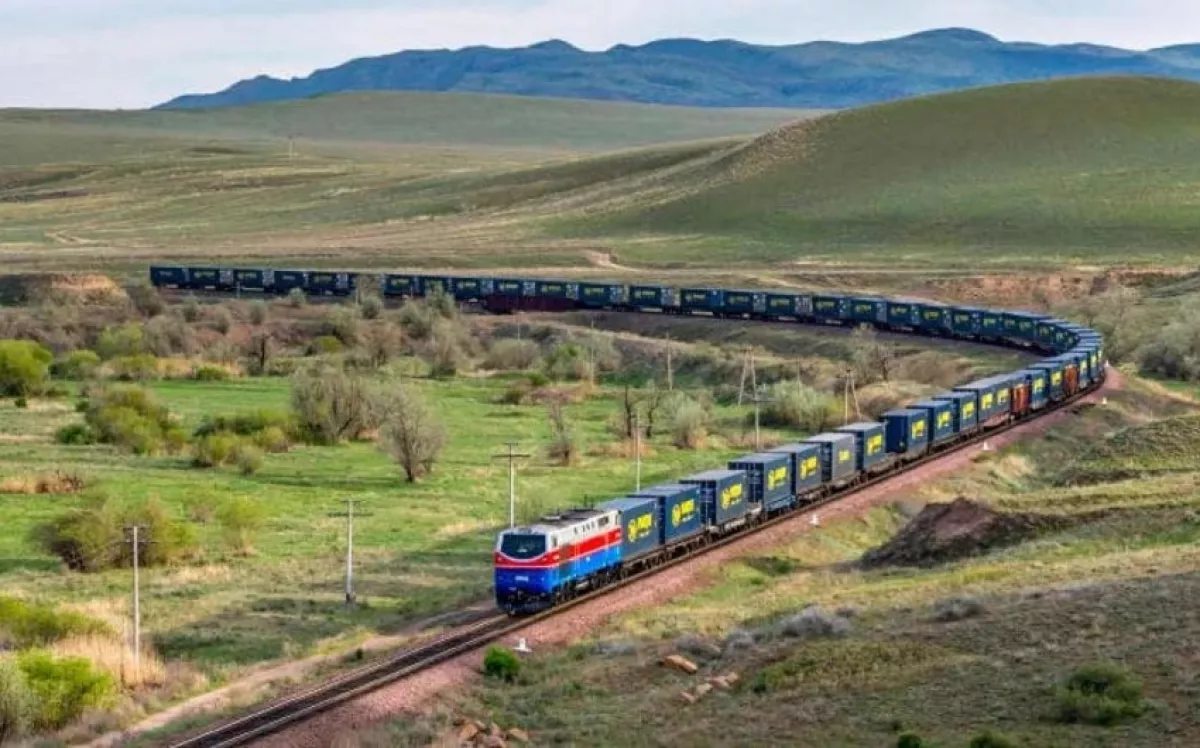A new direction for the Trans-Caspian route Middle Corridor set for explosive growth
Over the past three to four years, Azerbaijan has significantly stepped up efforts to strengthen its transport linkages with Central Asian countries and China, aiming to expand cargo transit along the Middle Corridor. A major milestone in this process was the recent presidential decrees ratifying the Azerbaijan-China intergovernmental agreement on “International Multimodal Transport,” signed in Beijing on April 23, 2025. Alongside this, a joint promotional plan supporting the Belt and Road Initiative was also approved.
To further optimise transport along the Trans-Caspian International Transport Route (TITR), the first cargo train recently departed from China’s Zhejiang province to Azerbaijan, passing through Turkmenistan.
Situated at the crucial crossroads of the East–West corridor, Azerbaijan has developed a modern and sophisticated transport infrastructure over the past two decades. Today, the country is focusing on advancing transport connectivity projects in partnership with China and Central Asian nations. Azerbaijan is actively cooperating with Central Asian countries, Georgia, Türkiye, and China to simplify cross-border procedures, reduce tariffs, and harmonise customs regulations. At the same time, it is undertaking large-scale projects to modernise and expand the Azerbaijani section of the Middle Corridor, responding to the rapidly growing demand for freight transport.
The scale of this demand is evident in the numbers: cargo volume transported along the TITR increased from around 600,000 tonnes in 2021 to 4.5 million tonnes by the end of last year—a remarkable 7.5-fold growth. Demand for container shipments has surged especially fast. In 2023, only 10 to 12 Chinese container block trains travelled along the TITR. By 2024, this number had jumped to 390 block trains, representing more than a thirtyfold increase.

Moreover, in 2025, cargo traffic along the Middle Corridor is expected to increase to 5.2 million tonnes, and the projected volume of freight transport could reach as much as 10 million tonnes annually by the end of 2027.
These projections are underpinned by new agreements between Kazakhstan, Azerbaijan, and China aimed at expanding cargo transportation.
“We know that connectivity projects in Central Asia are largely financed by the Chinese government. Another route toward the Caspian - that means toward Azerbaijan - so we must be absolutely prepared for that,” Azerbaijani President Ilham Aliyev said in an interview with Chinese television channel CGTN during his visit to Davos in February 2025. “I am sure that ‘One Belt, One Road’ initiative of President Xi Jinping will create additional opportunities for all countries.”

In April of this year, during President Ilham Aliyev’s three-day state visit to China, Azerbaijan and China signed an intergovernmental agreement on “International Multimodal Transport,” along with a joint plan to promote the Belt and Road Initiative. Both documents—designed to enhance transport connectivity with Chinese cargo shippers—were promptly ratified by presidential decrees.
As Belt and Road projects continue to gain momentum, Chinese freight forwarders are increasingly looking to diversify their westbound cargo routes. The Trans-Caspian corridor is emerging as a strategic alternative, especially in light of the disrupted Northern Corridor caused by Western sanctions on Russia. Additionally, the recently reignited Iran–Israel conflict has raised concerns over the stability of international maritime shipping routes, further underscoring the importance of secure overland alternatives.
Amid these complex geopolitical challenges, Azerbaijan Railways CJSC (ADY) and its Chinese partners are making steady progress in expanding rail links to Europe. Notably, projections suggest that by 2025, the volume of cargo transiting between China and Azerbaijan via multimodal container block trains on the “Baku–Xi’an” route could triple—reaching up to 1,000 train sets.
This shift is economically sound: container block trains originating in China take approximately 20 to 25 days to reach their destination via the TITR, which is nearly twice as fast as maritime shipments from China and Southeast Asia via the Suez Canal, typically requiring 40 to 50 days.
At the same time, due to the still-incomplete expansion of port and rail infrastructure in Kazakhstan, there has been a growing convergence between China’s Belt and Road projects and alternative routes within the Middle Corridor. A notable development in this context is the launch of the first freight block train from the city of Jinhua in China’s eastern Zhejiang province to Turkmenistan’s port of Turkmenbashi. The train is carrying 100 standard containers filled with clothing, accessories, metal goods, and other commodities.
The train is set to cross the China–Kazakhstan border at the Khorgos checkpoint, continue through key cities including Almaty, Tashkent, and Ashgabat, and then be transported by sea to the Baku International Sea Trade Port (BISTP) in Alat. This new route is expected to ease pressure on the existing logistics corridor between the ports of Aktau and Alat and to speed up the delivery of Chinese goods to Turkish and European markets.
The European Union has also designated the Port of Turkmenbashi as one of its priorities. During a recent visit to Turkmenistan, EU Commissioner Jozef Síkela described the port as a key hub between Europe and Asia. “We are developing the Trans-Caspian Transport Corridor — a fast, secure route connecting Europe and Asia in 15 days or less,” the Commissioner noted.

One of the key advantages of the new Middle Corridor route through the Port of Turkmenbashi is its strong multimodal potential and ability to integrate with other logistics initiatives in the Caspian region. Notably, this includes the Lapis Lazuli route—launched in December 2018 through cooperation between Baku and Ashgabat—which connects transport networks across Afghanistan, Turkmenistan, Azerbaijan, Georgia, and Türkiye. This combined rail, road, and sea corridor primarily facilitates the transit of non-oil cargo such as mineral raw materials, construction supplies, nitrogen fertilisers, textiles, dried fruits, and various agricultural products.
A growing share of cargo transport between the Turkmen and Azerbaijani ports relies on container shipments employing multimodal transport schemes, including transshipment via heavy trucks. Recently, the port and railway infrastructures of both Azerbaijan and Turkmenistan have been integrated into the international multimodal transport corridor known as CASCA+ (“Asia-Pacific Countries — China — Kyrgyzstan — Uzbekistan — Turkmenistan — Azerbaijan — Georgia — Türkiye — Europe”). This route spans three major regions—Central Asia, the South Caucasus, and Türkiye’s Anatolian region. The “+” in CASCA+ signifies its openness to new participants, reflecting a flexible and expanding network.








